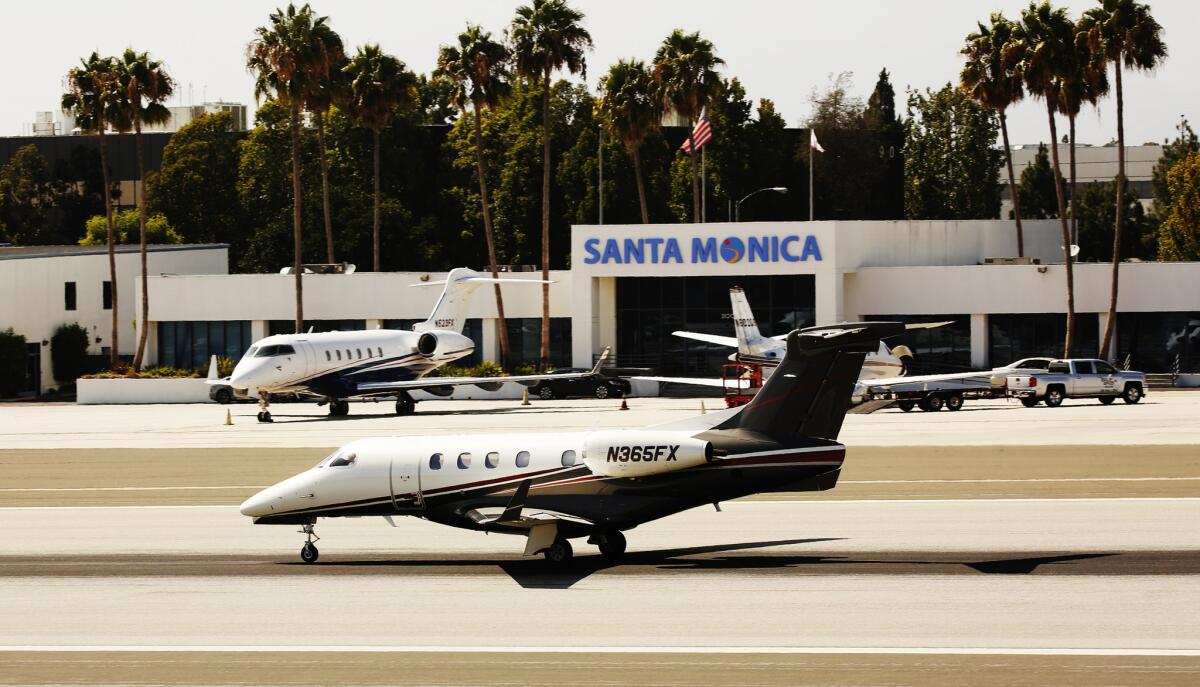Op-Ed: The plan to turn Santa Monica Airport into a park is irresponsible. The Westside needs housing

After decades of legal battles, Santa Monica Airport will cease operations for good in 2028. For many Santa Monicans, this no doubt feels like a double victory. Not only will they finally be free from the sound of jets and the stink of fumes, but the 227-acre airport site is also on track to become a public park.
But is that really what’s best for Santa Monica?
Residents certainly think so; they passed Measure LC in 2014, which requires a public vote to reuse airport land for anything besides public open space. The nonprofit organization Airport2Park was founded to realize this vision and enjoys the support of numerous environmental and stakeholder organizations from the surrounding community.
Although green space is certainly a more appealing use of city land than a parking lot for Harrison Ford’s planes, the opening of a the 227-acre site on the Westside — in close proximity to jobs, good schools and transit — is a once-in-a-generation opportunity.
Housing has to be a part of the equation.
Since the 1980s, Santa Monica has approved the construction of millions of square feet of office space, transforming it into a hub for both the tech and entertainment industries, with a daytime population that swells by more than 150,000 people. But this explosive job growth has not been accompanied by a proportional increase in housing units.
The opening of a the 227-acre site on the Westside — in close proximity to jobs, good schools and transit — is a once-in-a-generation opportunity.
Santa Monica’s estimated population of 92,478 residents in 2019 was only a blip above what it was in 1970, when 88,289 people called the city home. This growing imbalance between jobs and housing has created a massive influx of daily commuters into Santa Monica (even well-compensated tech employees) who either can’t find or can’t afford housing near these job centers. Meanwhile, population in neighboring jurisdictions has swelled, displacing lower-income residents. The result is more and more commuters crowding the freeways from increasingly distant parts of Southern California.
Studies have shown the average Angeleno wastes more than 100 hours each year stuck in traffic. They also, on average, spend more on rent relative to annual income than residents of virtually any other city in the United States.
Santa Monica residents are notorious for fighting new housing in their community on the grounds that the influx of residents will cause traffic. But the imbalance between employment and housing density on the Westside is a primary cause of traffic across the region, including in Santa Monica. More housing close to entertainment and tech job centers will ease traffic for everyone, especially if officials use the nine years until the airport’s closure to better connect the area to public transit.
Though Los Angeles County is known for being park-poor, residents of the Westside have more access to open space than much of Southern California. An estimated 87% of Santa Monica residents live within walking distance of a park. Just 61% of Angelenos can say the same. Residents living near the Santa Monica Airport are particularly well-served, with Venice’s Penmar Park and Santa Monica’s Clover Park and Airport Park (which is slated for expansion) all within walking distance.
That is not to say Santa Monica doesn’t need new parks, or that its redeveloped airport should be devoid of open space. But successful urban parks across the world, such as downtown L.A.’s Grand Park, are the “outdoor living rooms” of the dense, mixed-use communities built around them.
Click here for the full Livable City archive »
Grand Park was financed with a $50-million upfront payment from the developer of a neighboring project — a strategy Santa Monica could borrow to create open space at its airport while saving taxpayers money. The 12-acre park opened in 2012 — nearly seven years before any residential or commercial project broke ground. Santa Monica officials could negotiate a similar agreement in which park space is guaranteed to be funded and built at the airport, even if the private developments paying for those parks are subject to delays.
Santa Monica justifiably considers itself in the vanguard of progressive causes — particularly the fight against climate change. The city is currently developing a Climate Action & Adaptation Plan, which lays out strategies to reduce citywide carbon emissions to 80 percent below 1990 levels by the year 2030. According to UC Berkeley’s Carbon Footprint Planning Tool, however, building more infill housing is far and away the most promising strategy to achieve this goal. If the city is truly committed to hitting its targets, housing development at the Santa Monica Airport, located on the path of several bus lines and less than a mile south of the Expo Line, is an essential project.
Housing construction at the airport is currently disallowed by Measure LC, so city leaders will have to summon the political courage to take the case to voters. They’ll have a powerful argument.
Continued intransigence on building new housing will only increase greenhouse gas emissions — not just in Santa Monica, but also across the region. If the city is committed to fighting climate change, setting aside a portion of the 227-acre airport property for housing is common sense, no matter how politically difficult it may be.
Steven Sharp is the co-founder and editor of Urbanize.LA. Follow him on Twitter @UrbanizeLA.
Follow the Opinion section on Twitter @latimesopinion or Facebook
More to Read
A cure for the common opinion
Get thought-provoking perspectives with our weekly newsletter.
You may occasionally receive promotional content from the Los Angeles Times.










